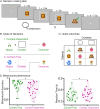Context changes retrieval of prospective outcomes during decision deliberation
- PMID: 39710609
- PMCID: PMC11663511
- DOI: 10.1093/cercor/bhae483
Context changes retrieval of prospective outcomes during decision deliberation
Abstract
Foreseeing the future outcomes is the art of decision-making. Substantial evidence shows that, during choice deliberation, the brain can retrieve prospective decision outcomes. However, decisions are seldom made in a vacuum. Context carries information that can radically affect the outcomes of a choice. Nevertheless, most investigations of retrieval processes examined decisions in isolation, disregarding the context in which they occur. Here, we studied how context shapes prospective outcome retrieval during deliberation. We designed a decision-making task where participants were presented with object-context pairs and made decisions which led to a certain outcome. We show during deliberation, likely outcomes were retrieved in transient patterns of neural activity, as early as 3 s before participants decided. The strength of prospective outcome retrieval explains participants' behavioral efficiency, but only when context affects the decision outcome. Our results suggest context imparts strong constraints on retrieval processes and how neural representations are shaped during decision-making.
Keywords: EEG; context; decision-making; multivariate decoding; outcome retrieval.
© The Author(s) 2024. Published by Oxford University Press.
Figures






Similar articles
-
Reinstated episodic context guides sampling-based decisions for reward.Nat Neurosci. 2017 Jul;20(7):997-1003. doi: 10.1038/nn.4573. Epub 2017 Jun 5. Nat Neurosci. 2017. PMID: 28581478
-
Neural Signatures of Controlled and Automatic Retrieval Processes in Memory-based Decision-making.J Cogn Neurosci. 2016 Jan;28(1):69-83. doi: 10.1162/jocn_a_00882. Epub 2015 Sep 24. J Cogn Neurosci. 2016. PMID: 26401812
-
Neural dynamics encoding risky choices during deliberation reveal separate choice subspaces.Prog Neurobiol. 2025 Jul;250:102776. doi: 10.1016/j.pneurobio.2025.102776. Epub 2025 May 7. Prog Neurobiol. 2025. PMID: 40345520
-
Increased functional connectivity between dorsal posterior parietal and ventral occipitotemporal cortex during uncertain memory decisions.Neurobiol Learn Mem. 2015 Jan;117:71-83. doi: 10.1016/j.nlm.2014.04.015. Epub 2014 May 10. Neurobiol Learn Mem. 2015. PMID: 24825621 Free PMC article.
-
Normative decision rules in changing environments.Elife. 2022 Oct 25;11:e79824. doi: 10.7554/eLife.79824. Elife. 2022. PMID: 36282065 Free PMC article.

